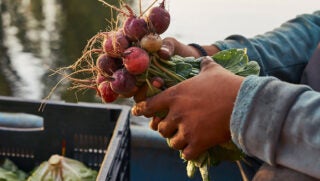American Farmland Trust released “Advancing Understanding of Conservation on Rented Land” to mark Earth Day and call attention to the importance of speeding the implementation of conservation practices on rented farmland and ranchland in support of goals to improve and protect our environment.
The paper explores the discoveries of AFT’s 2020 research report — “Understanding and Activating Non-operator Landowners” — dispelling myths and highlighting important and necessary actions to improve non-operator outreach and education and bring landowners and renters together on shared goals.
Forty percent, or over 350 million acres of farmland and ranchland across America, is rented or leased, most not owned by the farmers and ranchers working the land. “Non-operator landowners”(NOLS) are increasingly identified as a group of landowners who should be included when discussing environmental issues on agricultural lands. Yet, who NOLS are and what we know about them in terms of conservation has been limited. AFT set out to change this. Completing a multi-state survey in 2020 focused on the 13 states with the largest number of rented acres, AFT provided the most comprehensive set of data on NOLS since the 2014 Tenure, Ownership, and Transition of Agricultural Land Survey conducted by the USDA National Agricultural Statistics Service and provided actionable findings for conservationists.
“We must harness these landowners, the lands they lease and farmers who farm the land to meet the high stakes goals for regenerative agriculture, climate change mitigation and the protection of 30 percent of our nations farmland by 2030,” said Gabrielle Roesch-McNally, AFT’s Women for the Land director and co-author of the NOLs research report and white paper. “We must focus on education and outreach but also on building the relationship between farmer and landowner with conservation on the land as the ultimate outcome.”
“Advancing Understanding of Conservation on Rented Land” analyses the larger research findings, sharing assessments of — who are non-operator landowners, what is their involvement in conservation, their relationship with renters, and what information sources and needs do they have? Most importantly, this paper, published in the Journal of Soil and Water Conservation, identifies future work that could lead those in agricultural service provision, farmland preservation, and conservation arenas to focus their efforts with NOLs to improve conservation outcomes on the landscape.
What is very clear is that NOLS are interested in implementing conservation on their land, not just in “getting their next rent check”, a myth that has been perpetuated to the detriment of broader implementation of conservation practices. Greater action is needed to find, reach out to, and engage with NOLs and ultimately their renters to help them access technical and financial resources that will increase the implementation of regenerative farming practices on their lands, help to mitigate climate change and protect and conserve 30 percent of working farmland and ranchland to achieve 30×30.


